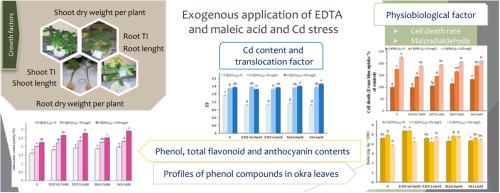Journal of Environmental Chemical Engineering ( IF 7.4 ) Pub Date : 2021-04-15 , DOI: 10.1016/j.jece.2021.105456 Afsaneh Mousavi , Latifeh Pourakbar , Sina Siavash Moghaddam , Jelena Popović-Djordjević

|
The effects of Cd application alone or along with ethylenediaminetetraacetic acid (EDTA) and maleic acid (MA) were explored in okra (Abelmoschus Esculentus.L.). Okra plants were planted in hydroponic conditions and in the 4-leaf stage, they were exposed to cadmium nitrate at three levels (0, 50, and 100 mg/L) and/or EDTA and MA at two levels (0.5 and 1.0 mM) and the combined application of different Cd concentrations with EDTA and MA for one month. The results showed a decrease in shoot and root dry weight and length and an increase in malondialdehyde (MDA), cell death, Cd accumulation, anthocyanins, and phenol and total flavonoid contents in the Cd-treated plants. The application of EDTA and MA alleviated the detrimental impacts of Cd on the okra plants by the improved management of translocation, compartmentation, and tolerance index. HPLC method revealed that rosmaric and coumaric acids were the most abundant phenolic compounds among the studied compounds. The variations of the phenolic compounds in the Cd-treated plants versus the control showed that the greatest increase was in chlorogenic acid (101.91%) and the greatest decline in coumaric acid (60.90%). The highest increase and decrease in the plants exposed to Cd with EDTA or MA versus the plants only exposed to Cd were related to coumaric acid (106.60%) and chlorogenic acid (43.45%) related to the treatment of 100 mg/L Cd + 1 mM MA, respectively. In conclusion, okra has good potential for the phytoremediation of Cd and the EDTA and MA increased the phytoextraction efficiency.
中文翻译:

EDTA和马来酸的外源施用对暴露于Cd胁迫下的秋葵(Abelmoschus esculentus L.)的耐受性,酚类化合物和镉的植物修复作用
在秋葵(Abelmoschus Esculentus.L。)中研究了单独施用镉或与乙二胺四乙酸(EDTA)和马来酸(MA)一起施用镉的效果。黄秋葵植株在水培条件下种植,在四叶阶段,它们分别暴露于三种浓度(0、50和100 mg / L)的硝酸镉和/或两种浓度(0.5和1.0的EDTA和MA)下 mM),以及将不同Cd浓度与EDTA和MA联合使用一个月。结果表明,镉处理过的植物中茎和根的干重和长度减少,丙二醛(MDA),细胞死亡,镉积累,花色苷和酚以及总黄酮含量增加。EDTA和MA的应用通过改进对易位,分隔和耐受指数的管理,减轻了Cd对秋葵植物的有害影响。HPLC法显示,在所研究的化合物中,迷迭香酸和香豆酸是最丰富的酚类化合物。Cd处理植物与对照植物中酚类化合物的变化表明,绿原酸的增幅最大(101.91%),香豆酸的降幅最大(60.90%)。 mg / L Cd + 1 mM MA。总之,秋葵具有对Cd进行植物修复的潜力,而EDTA和MA可提高植物的提取效率。











































 京公网安备 11010802027423号
京公网安备 11010802027423号